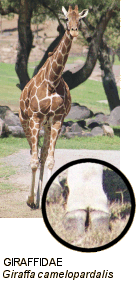 |
The family Giraffidae has two extant members: the savannah-dwelling giraffe
(Giraffa camelopardalis) and the forest-living okapi (Okapia
johnstoni). Native to Africa, this family is highly adapted for browsing
- although the two species inhabit very different habitats, both feed at
a level higher than any other sympatric terrestrial herbivore. The giraffe
is the tallest living mammal, towering up to 5.9 meters above the ground.
While giraffes are renowned for their long necks, they possess the same number
of cervical vertebrae - seven - as most other mammals. The forequarters of
both species are overdeveloped, and the back slopes downward to the rump.
The fossil record of the Giraffidae begins in Africa during the Miocene, extending to the present on this continent. Giraffes also ranged widely in Eurasia from the middle Miocene to the Pleistocene. Some of these giraffes bore highly developed, branching ossicones (see below). The modern-day okapi, on the other hand, closely resembles the ancestral form of the early Pliocene giraffids (Paleotragus). Two subfamilies (or tribes) are sometimes recognized:
The legs are long to very long, and have only two digits. Giraffids walk with an ambling or pacing gait, with the front and rear legs on one side of the body moving forward together - since the body is relatively short, this ensures the legs do not interfere with each other. The extreme length of the legs means that giraffids have to straddle or bend their front legs in order for their heads to reach the ground to graze or drink. Both the giraffe and okapi possess a long, prehensile tongue with which they browse. Leaves form the principal diet of both species; giraffids select for high-quality foliage, and have a very efficient digestive system with which to process it (the stomach of the giraffe is half the size of that of the grazing African buffalo, Syncerus caffer). Tongue-like papillae in the stomach provide the largest absorptive surface of any ruminant. The teeth of this family are characteristically rugose - the enamel is not smooth as in all other mammals. The Giraffidae maintain the typical ruminant dentition: I 0/3, C 0/1, P 3/3, M 3/3 x 2 = 32. A pair of skin-covered bony knobs (known as ossicones) are present in both species: in Okapia they grow from the frontal bones in males only; in Giraffa both sexes have ossicones on the parietal bones. Ossicones of modern giraffes are short and unbranched, and are never shed. In Giraffa, layers of bone are often laid along the suture between the frontal and nasal bones, forming a third protuberance which is especially prominent in adult males. At birth, the ossicones are present as cartilaginous knobs, which ossify, grow, and fuse with the skull with age. |
(From Hernandez-Fernandez and Vrba, 2005)
| Return to Artiodactyla |
Giraffa camelopardalis |
or jump to the Giraffidae Species List